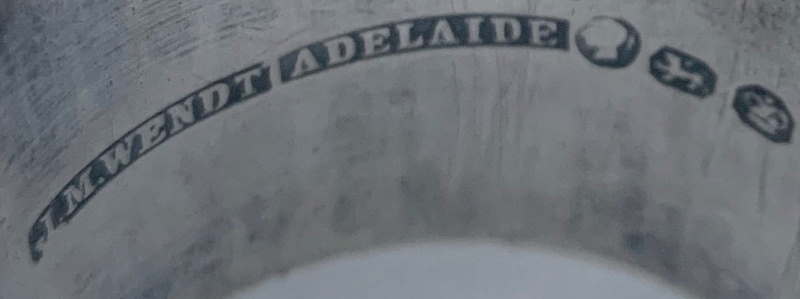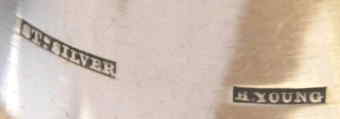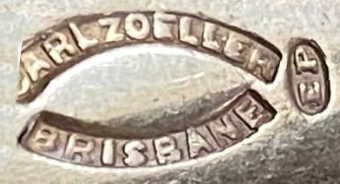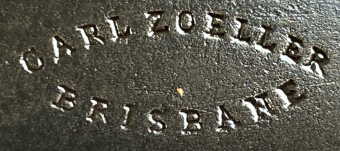THE DIRECTORY OF AUSTRALIA SILVERSMITHS
|
|
|
created by Giorgio B. owner of www.silvercollection.it ©  |
| This is a page of A Small Collection of Antique Silver and Objects of vertu, a 1500 pages richly illustrated website offering all you need to know about antique silver, sterling silver, silverplate, sheffield plate, electroplate silver, silverware, flatware, tea services and tea complements, marks and hallmarks, silver marking system and silver hallmarks guide, articles, books, auction catalogs, famous silversmiths (Tiffany, Gorham, Jensen, Elkington, WMF, Reed & Barton, Mappin & Webb, Bateman Family), history, oddities ... SITE MAP - HOME PAGE |
| AUSTRALIA SILVERSMITHS ALPHABETICAL LISTING - W - X - Y - Z - |
| AUSTRALIAN SILVERSMITHS
A
B
C
D
E
F
G
H
I
J
K
L
M
N
O
P
Q
R
S
T
U
V
W
X
Y
Z
NOT IDENTIFIED ALPHABETICAL LISTING OF MARKS |
(click on the photo to enlarge image)
| SILVERSMITH'S NAME AND MARKS |
SILVERSMITH'S INFORMATION |
| WALSH Alfred WALSH & Sons (Alfred and Frederick) WALSH BROS. (Alfred and Frederick) 

|
Victoria, Melbourne active 1850s/1910s |
WENDT Joachim Matthias





 |
South Australia, Adelaide Born in Denmark, Joachim Matthias Wendt (1830-1917) began the business in 1852 as watchmaker and jeweller at Pirie Street, Adelaide, and in the same year opened premises at 68 Rundle Street. He moved to larger premises at 84 Rundle Street in 1861 and then no. 70 in 1874.J ulius Ludwig Schomburgk (ca.1818 -1893), a brother of Moritz Richard Schomburgk, was for many years Wendt's principal designer and workshop foreman. His business expanded steadily until it became one of the largest and best known in Australia. In 1869 he opened another shop at Mount Gambier and in 1888 another in Broken Hill, New South Wales, though this business was sold around 1895. In 1903 his son Julius M. 'Juli' Wendt and stepson Hermann Koeppen-Wendt were brought in as partners in the firm and took over its management. Business was transferred to a new shop at 74 Rundle Street in December 1904, with an optician's department and workshops on the first floor. Jule moved to London leaving Hermann in charge of the Adelaide business. When J. M. Wendt senior died in 1917, Hermann Koeppen-Wendt inherited the business. In 1927 his son Alan was brought into the company as an equal partner with his father, and in 1938 inherited the business, bringing his son Peter in as a partner in 1946. The company became Wendts Pty Ltd.in 1947 with Alan and Peter as directors. |
WILLIS THOMAS (possibly) |
Victoria active 1880s |
WILLIS & SONS |
Victoria, Melbourne Founded in 1868 by Richard & Thomas Willis. Figural trademark UNICORN. |
YOUNG & COMPANY
 |
Victoria, Melbourne active 1880s |
ZOELLER KARL
 |
Queensland, Brisbane Zoeller, born in Germany and naturalised Australian, when WW1 began was interned and after the war was deported back to Germany, ending his life in South Africa. Zoeller retailed items manufactured by ABRAM BROOKSBANK & CO and T. Turner & Co of Sheffield |
|
HALLMARKS OF ENGLISH SILVER -
MAKER'S MARK IDENTIFICATION
|
| IMAGES | A& AC |
AD AK |
AL AZ |
B& BB |
BC BO |
BP BZ |
C& CA |
CB CC |
CD CF |
CG CL |
CM CS |
CT CZ |
D& DB |
DC DL |
DM DZ |
E& EA |
EB ED |
EE EH |
EI EO |
EP EZ |
F& FD |
FE FJ |
FK FZ |
G& GB |
GC GG |
GH GL |
GM GR |
GS GZ |
| IMAGES | H& H& |
HA HB |
HC HE |
HF HL |
HM HU |
HV HZ |
I& IG |
IH IL |
IM IZ |
J& JA |
JB JC |
JD JG |
JH JK |
JL JQ |
JR JR |
JS JS |
JT JZ |
KA KZ |
L& LB |
LC LZ |
M& MB |
MC MI |
MJ MZ |
N& NZ |
OA OZ |
P& PK |
PL PZ |
QA QZ |
| IMAGES | R& RB |
RC RG |
RH RK |
RL RQ |
RR RZ |
S& SB |
SC SI |
SJ SR |
SS SZ |
T& TC |
TD TG |
TH TN |
TO TS |
TT TZ |
UA UZ |
V& VZ |
W& WA |
WB WB |
WC WC |
WD WE |
WF WG |
WH WL |
WM WM |
WN WR |
WS WS |
WT XZ |
YA YZ |
ZA ZZ |
|
BRITISH TOWN MARKS AND DATE LETTERS
|
AUSTRALIA AND ITS SILVER
A BRIEF HISTORY
|
|
